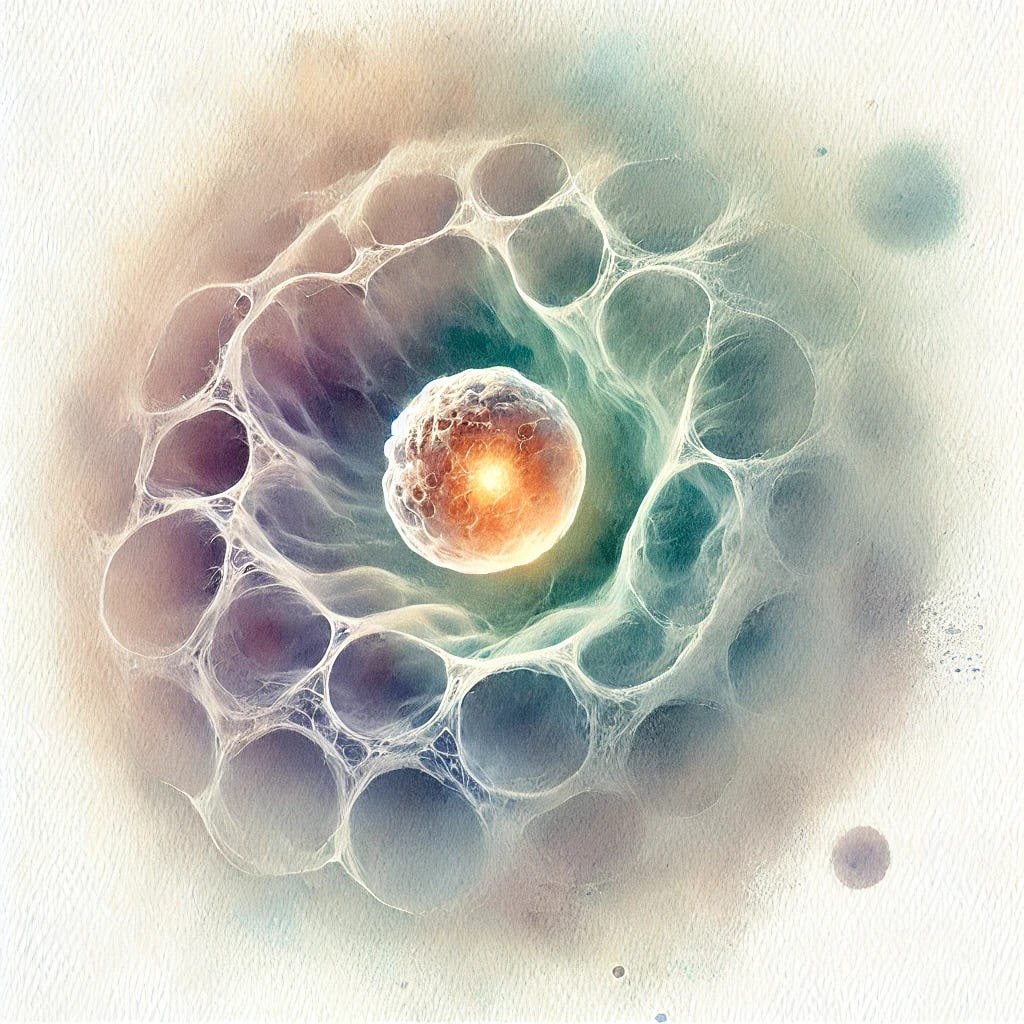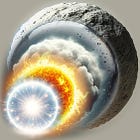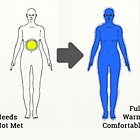Psychotopology emerged through a unique intersection of orthogonal forces: the subjectivity of my personal journey with the objectivity of scientific inquiry. Both were essential. This unique combination played a bigger role in the emergence of psychotopology than any other factor, and I believe it sheds some light on why these discoveries have taken so long to make themselves known to us.
My Style of Being: Feeling at the Center
From early childhood, I experienced myself as different from those around me. It was as though other people were foreign, alien, and I could not understand what drove them to behave in the ways they did.
Much of that perplexing behavior centered around my parents saying or doing things that seemed so obviously out of sync with reality as I experienced it — and as they seemed to actually experience it, if I looked beyond their surface words and actions. I don’t want to go into indulgent details, but various examples of my father’s abusive behavior come to mind, along with his habitual reliance on authority to define reality instead of being present to what was actually real in our lived experience. My mother embodied the possessed and dominated female, internally consumed by her own pain and simply not present with others around her.
I felt the incongruence, and I trusted my perception above the shaming and punishment intended to push that aside. Unfortunately, my parents kept us pretty isolated, and I never had access to an adult I could trust, so I was alone with this feeling-based reality sensor at my core. As I grew up, I came to rely more and more upon this center of feeling to ground myself, to extend my presence into nature, and to support my ongoing inquiry into how this world works.
My Style of Thinking: Structural and Integrative
My primary mode for making sense of the world is structural and spatial rather than analytic and linguistic. I feel my way into problems and through to their solutions.
I remember becoming more saliently aware of this while taking organic chemistry as a pre-med sophomore at the University of Pennsylvania. Most of my peers seemed to approach this class primarily as a memorization exercise. I found myself able to feel into the molecular structures more intuitively, structurally, spatially, in ways that enabled me to understand the dynamics of the chemicals and reactions more directly. I didn’t need to rely on memorization to follow the formulas, and did reasonably well in the course without attending class or reading much of the text until the last few days before the final (crunch time!). This aptitude has served me well over my life, including very definitely in the development of psychotopology.
In addition to this foundation of structure in my approach to understanding, I have a strong tendency to connect everything to everything else. I want to see the context for every detail, and my drive is to see, feel, and understand the relationships above all. Rather than use an analytic and reductive approach, I much prefer to build looser and more integrated syntheses of the whole.
To me, as I have sought to understand the phenomenon of consciousness, everything is included and all is interconnected — people’s behaviors and everyday experiences, unusual states, societal phenomena, the many approaches to understanding itself — all of it.
Just as important, or perhaps even more so, has been a kind of ethic or aesthetic that guides my ongoing inquiry. In my experience, beauty and elegance serve as guiding lights. When after long contemplation of an inquiry I discover a new insight that answers not only the question I held but several others in a way that simplifies and makes the whole more beautiful and elegant, I hold that as an affirmation. Such coherence excites and inspires me, and fuels years-long pursuits of deeper understanding.
On One Hand, a Few Disadvantages
Although I would probably consider this style of thinking my “superpower,” it comes with several distinct disadvantages.
The first disadvantage is its pace. This is a very slow way of building and evolving an understanding about a large-scope topic, perhaps especially that of conscious experience. This effect is intensified by the fact that much of the ongoing evolution of my structural understanding proceeds outside of my explicit awareness, implicitly through the evolution of the structure of my self. (I’ll have more to share about this in a future post.)
The second disadvantage is its non-verbal nature. The sequential nature of language does not lend itself well to presenting non-linear structures, so it has been difficult to put words to my understanding as it has grown. Here as I build this ‘stack, I am feeling my way through, and it takes significant effort to bring it out and make it explicit — even to myself at times.
The third disadvantage lies in how the interconnectedness of everything adds to the difficulty of speaking about it. For me, any point I might undertake to explain draws its meaning from innumerable connections to other places in my system. Trying to convey a small chunk of the whole feels almost impossible within the constraints of others’ attention spans and expectations for digestible, isolated chunks.
Because of the challenge in sharing my evolving understanding, it has remained relatively invisible to the outside world. This has made it hard to find allies and collaborators.
These four disadvantages have conspired to keep me pretty isolated. Operating in this way, I haven’t seen any way to fit myself into a setting that would give me institutional or other significant support. This structural way of thinking might have a place in theoretical physics or someplace similar. But the fields concerned with psychology and consciousness tend to be extremely committed to the dominant linguistic/analytic forms of engagement. Which is not something I have either an ease with or a tolerance for.
It has been a long, lonely slog, and I have been working outside of existing networks the entire time.
On the Other Hand, an Advantage
Despite these disadvantages, I wouldn’t give this mode up for anything. At this time in my life, things are finally cohering into a beautiful, all-encompassing model of the universe of conscious experience. There are many undeveloped zones in my model, but as a whole it is beautiful and elegant in just the way I appreciate most. I love it, and it helps me make sense of the whole human experience — my own along with those experiences reported by others, as well as the broader societal phenomena that emerge from our collective presence and activity.
It’s exciting to me! And while, yes, it is damned hard for me to extract this model into explicit concepts and language that convey this understanding to you and others, I can see clearly its precious value and am willing to do the necessary work, no matter how long it takes me. So here I am.
My Focus: Conscious Experience
Holding feeling at the center of my lived experience — and maintaining that in contrast to the way most people place thought at the center — brought me into an excruciating chasm between the many human stories about reality, especially human reality, and my own experience. The most acute point of separation between these two domains came when I was diagnosed with bipolar disorder at age 27.
According to the science as held by the medical establishment, and psychiatry in particular, my intense experiences in the high and low extremes of mood were caused by faulty brain chemistry. The way to “correct” this imbalance was through chemical intervention.
There was nothing in this story, though, that spoke to my actual experience. I could see that by centering my experience on feeling, I had a tendency to amplify any strong mood by giving myself fully to its influence. This was true for both highs and lows. I held both as prime locations of potential wisdom and understanding, and by fully committing to my moods (both high and low) and habitually intensifying them, I regularly experienced profound epiphanies and insights into my own life and the universe as a whole. To me, brain chemistry imbalance did make sense, but as a consequence of my pattern, not a cause of it. And I did not want to give up these portals to insight.
At the same time, I recognized that the way I typically conducted these intense explorations did create constant disruption in my life. I prioritized these deep dives over career, relationships, and financial stability. Something did need to change.
At this point, I became fascinated by the cycles as they ran through me. I didn’t have full agency over when the various moods would emerge, and that became troubling. It seemed to me there was a pattern lurking beneath the surface, as if the cycles were driven by a hidden clock mechanism. A discrete, almost predictable pulse seemed to be driving me, and I and wanted to find out how it worked.
Slogging
Over the next seven years, I devoted myself to digging as deeply into this inner mystery as I possibly could. I made progress, and my life became very slowly, very gradually less chaotic over time. But the deeper I dug, the more mystery I discovered. Chamber after chamber of pain and grief and rage emerged into the light.
Here is an example to give you an idea of the way I was proceeding at this time. An intense inner rage showed up for me in the context of a relationship. The intensity of the rage scared me — it felt capable of violence — and I separated from my girlfriend to protect us both.
One way I had developed to work with my intense states was through self-hypnosis and regression, walking the state back to its origins earlier in my life so I could process the memories in some way. This rage was too intense for me to work with it alone, so I sought the help of a hypnotherapist. The regression brought me back to the womb, a few months before birth.
A conversation with my mother a couple months later revealed that she had not wanted to marry my father, that she had intended to give me up for adoption, but that he and her father forced her to go through with the marriage. The timing of the origin of my rage coincided with their marriage and the difficult (for her) months afterwards. It was as if I did not want to be raised by my father, or by them both, and that the marriage felt like a form of betrayal.
This way of working seemed it would never end. There was always a sense of arbitrariness to the interpretations of past events, and an incompleteness because of the endless networks of connected events both known and unknown. If I learned or remembered something new about my past, my interpretations would change, my story would change, and there was no way to know when I had arrived at the “truth” of things.
This was not science. It was a personal journey through the story of my past, meaningful and helpful but not shedding clear light on the deeper mechanisms of my mood cycles. Both my need and my curiosity remained high.
At the time, I wasn’t thinking about my drive to understand in terms of science. I was blindly grokking, fumbling along, hoping for something to emerge. If I had thought about it as a potential scientific inquiry, though, it would have been clear what was missing.
Science relies upon observation. If we want to learn about a particular territory, we must be able to observe that territory with precision and discipline. The purpose of our observation is to construct a map of the territory, and once we have a map, we use observation and intervention to test it.
At the simplest level, maps are made of three key components. First are entities — regions of the territory which remain relatively stable. Then there are relationships — patterns of connection and process between and among the entities. Finally there are contexts — other, related maps with which our emerging entities and relationships connect.
In the way I had been seeking to understand what drove my mood cycles, there was no way to surface this kind of structure. All the events of my past were fluid, changing constantly with new memories and information. All of my current responses to my history were also very fluid and difficult to grasp. There was no way to make a reliable, consistent map of what was going on for me. And in the bigger frame, even if I had succeeded in making a map of my own personal interior that worked for me, applying that map to anyone else would have been vague and general at best.
Again, this was no science. It was, however, a kind of pre-scientific collection of observational data. I was immersed in this realm of inner experience, poking here, pushing there, wandering wherever something invited me, gathering experiences and keeping my interpretations relatively open. This broad collection of diverse direct experiences and loosely-knit ways of interpreting those set me up for what came next.
The Fluke That Opened the Door
Then something weird happened. Lying in bed one sunny afternoon, depressed, I deliberately reversed the downward sensation of gravity in my chest, and found myself suddenly cheerful. (I tell a little more of this story in A New Method for Observing Inner Experience.)
This was the seed out of which grew a method by which to observe the actual inner experience of feeling, mood and emotion with precision and discipline. This method revealed a rich, tangible world made of the proto-language of virtual materiality. Feeling states were made of virtual material stuff.
This new capacity to observe feeling states shifted the focus of investigation from the contents of conscious experience to the structure beneath those contents. The virtual material feeling spaces made visible through this new method were very different from the ordinary stories, memories, interpretations, and other thought-centered ways of articulating conscious experience. Now I was able to step behind the facade of story into the machine room behind it, to see the actual scaffolding holding all story in place.
Not only did this new method function as an instrument of observation, enabling me to begin to craft maps of this territory. It also enabled direct, precise interventions by which I could test these maps. It was possible to observe a feeling state, revealing a tangible presence made very distinctly of unique virtual material properties, and then to interact with those properties to directly and instantly shift the experience of the feeling.
Right away, it became clear that this shift in focus from contents to the underlying structure of conscious experience enabled new possibilities to pursue new questions in the science of subjective experience. Above all, for me, was the question about the nature of this underlying structure. What exactly was I working with when transforming a feeling state from fear to confidence or from sadness to joy in just a few minutes?
With this new tool, and the emerging map of some kind of underlying structure, I was finally able to make steady and significant progress, as you will see.
Coming Up Next: A New Method for Observing Inner Experience
Next week I will go further into my discovery experience and what it revealed. And the week after that I will post a Fieldwork Quick Start, so you can put on your own “white coat” and step into the lab of your own inner world.
I’m looking forward to your questions and discoveries!
Reflections
Here’s your chance to influence how I move forward by adding your reflections in the comments below.
How does this post land for you?
What in you feels like it is being spoken to in this post?
What questions are you left with? What are you most curious about?
What feedback would you like to offer me, in service to my being able to share this new work with you and the world?
What feedback could you offer toward improving my writing of this post?
Comments are open to all, and I do hope you will consider also subscribing so we can stay in the loop with one another as this evolves.
Thank you.
Thank you for being here, thank you for reading, and thank you for sharing your thoughts in the comments below. I look forward to meeting you soon.
One last note. I’d love for you to thoughtfully spread the word about Frontiers of Psychotopology. For example, reach out to someone you think would appreciate this, and tell them why. Alternatively, here on Substack, feel free to share with your beloved subscribers or restack this post or a quote that was most meaningful to you.





I loved hearing about the life experiences that felt significant for you. These were very meaningful to me, as they resonate as truth in my soul. Thank you for sharing yourself in this way. 🙏🏽
A reliable method for self-observation, without getting tangled up in selves and egos and unresolved questions of 'which bit is me doing what to which other bit?', sounds good to me.